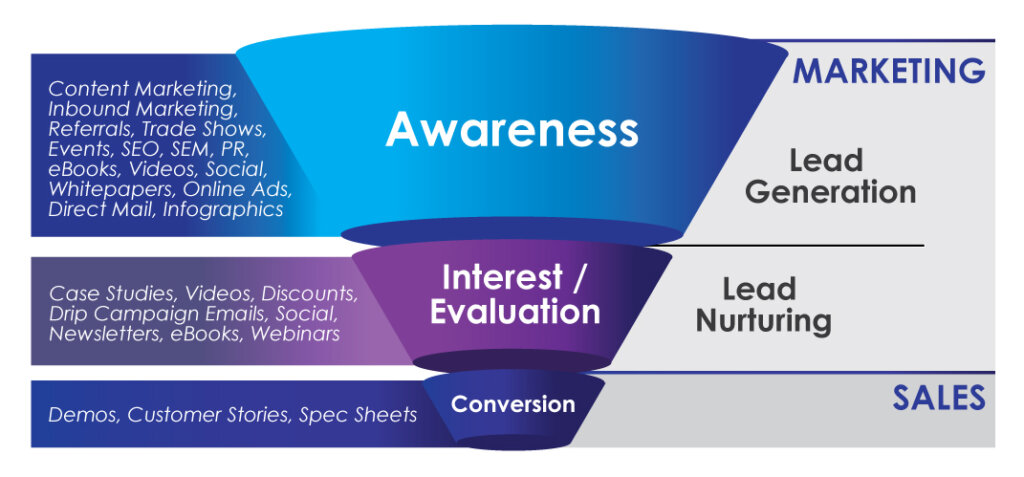3 Effective Lead Nurturing Tactics
Lead nurturing is a critical component for improving your business results.
If you’re building email lists or gathering leads through any other methods, it’s important that you keep them engaged. A common mistake is to spend time and money on gathering leads, only to let them go “stale.”
This means that by the time it occurs to you to send out an email or get in touch another way, the people on your list may have forgotten who you are. They’re less likely to pay attention to your email and even less likely to take the action you were hoping for.
Lead nurturing means that you have plans and systems in place to stay in touch and keep those leads “warm.” Doing so gives you a better chance of converting those leads to customers because you can keep them engaged and interested in the value your business can provide.
What are some successful examples of lead nurturing tactics? Here are some we’ve tried and tested…
#1. Target different stages of the funnel
When we talk about the marketing funnel, it’s a way to visualize the steps a new lead may go through from discovering your business to deciding to make a purchase. The beginning and middle of a traditional funnel includes a variety of marketing efforts and tactics before handing off to sales, as illustrated in the diagram below:

The funnel demonstrates that not all leads will continue through every stage. For example, you might draw in a large number of new leads via a marketing campaign, but many of those may drop out and not continue to the lead nurturing phase. It’s usually natural attrition – you’re always going to net some initially who aren’t ideal customers for your product or service (or it’s the wrong time for them). It’s natural and expected to drop some leads off at each phase.
The idea is that through lead nurturing, you shepherd people through the funnel and hopefully, keep more onboard! One important strategy to help with this is to run targeted campaigns for each stage of the funnel.
Companies often try to go straight to the sale at the bottom of the funnel. They target a lot of their marketing spend and effort at that phase, while mostly ignoring the rest of the funnel.
This can be a costly mistake. First, the bottom-of-funnel is highly competitive and therefore more expensive to target. In something like a PPC campaign, you’ll almost always be paying a lot more to target ads to people who are very close to a purchase decision.
Second, the nature of a funnel is that people don’t tend to go straight from the top (becoming aware of your business) to the bottom (making a purchase). Different industries may find people go through faster or slower – big ticket items tend to be slower. If you ignore all the people in the middle or keep showing them “here, buy this” advertising, you’ll most likely lose a good portion of your leads, unless you’re diversifying your messaging to meet the needs of your audience for this funnel stage.
A better approach is to consider the target audience’s goals and serve them up content to help them achieve those goals. For example, someone who is evaluating different types of solutions to a problem that you solve might appreciate content that shows them a fair comparison.
We could sum this up by giving you two key goals as you consider your funnel:
- Map each stage of the customer journey – what are their goals or concerns?
- Keep all leads in your funnel engaged with content that matches their stage.
#2. Be timely
Unfortunately, many businesses aren’t following up in a timely manner with leads. We’ve seen companies spend a considerable investment on attending trade shows where they collect a bunch of leads, only to do nothing about them until months later.
At this point, the lead is more than likely “stale.” They may not remember who you are or how you would happen to have their contact information. The best time to follow up is as close to the initial interaction as possible. Various studies have shown that your chances of converting a lead into a sales prospect are much better when they are contacted immediately.
So, why isn’t timely follow-up happening? Most often, it’s because the company doesn’t have a good system in place that will allow them to easily track and keep in touch with leads. Marketing automation is your friend here. Tasks that involve manual work tends to be overlooked or put on the backburner. Automate as much as possible, including how you get leads into your system. From there, automated lead nurturing allows you to trigger emails and other content based on actions, as well as set alerts or reminders if someone needs to be contacted via phone. Timely, automated, and well-planned content will get you much better results than relying on cold calling.
#3. Use multiple channels
In the past, lead nurturing consisted of email campaigns or picking up the phone to call leads on a list. These methods are still effective – in fact, email marketing continues to yield results with 99% of people across all age groups checking their emails at least daily.
What has changed is that more people are using different online channels. Omnichannel marketing has grown in the last few years with the use of multiple channels and devices while creating a seamless experience for customers. This is shown in the diagram below from SparkPay:
It’s important to review and consider the best channels for your business and where possible, engage in omnichannel marketing strategies to deliver seamless and integrated experiences your customers will expect. V12 shared a few pertinent statistics:
- Companies with extremely strong omnichannel customer engagement retain on average 89% of their customers, compared to 33% for companies with weak omnichannel customer engagement.
- 90% of customers expect consistent interactions across channels.
- Businesses that adopt omni-channel strategies achieve 91% greater year-over-year customer retention rates compared to businesses that don’t.
Marketing automation platforms are a great tool to facilitate effective multi- or omnichannel lead nurturing activities. Tracking pixels and automated technology make it possible to segment your audience and to present people with highly relevant information for their stage in the marketing funnel.
This also enables you to deliver a consistent experience for your leads and customers. People often go through multiple interactions before making a decision, and most of the time this involves a variety of devices and platforms. They will expect a consistent experience, no matter which channel they are using, and automated marketing strategies help you deliver that! For example, it wouldn’t make sense to keep showing people the exact same content each time they had contact with your marketing campaigns. Segmenting helps to keep relevant content in front of your leads at each stage of the buyer’s journey.
To give an example of using multiple channels: you might set up a series of automated email sequences; share similar content on your social media channels; set up paid retargeting campaigns (through social media or dynamic web content); and reach out to contacts over the phone. This will give you important insight for lead interactions and allow you to modify and improve for best results.
Final thoughts
The bottom line here is that you must prioritize lead nurturing. At the very least, don’t let those valuable leads go stale! Keep people engaged through regular communications so that they’re more likely to remember you and ultimately become a customer.
Advanced and effective lead nurturing strategies include creating and targeting content for specific buyers, considering the stages of the funnel, and using marketing automation. It makes sense to show people content that is highly relevant to their needs and goals. Fortunately, marketing technology is here to help.
Do you need help with setting up effective, automated lead nurturing strategies? Check out Paragon Digital Marketing and send us a message. We’d love to help!












